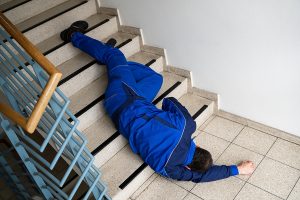What Evidence Do I Need To Collect To Prove My Slip And Fall?
 Michael Babboni
Law
We can all be a little clumsy sometimes and trip over our own feet. However, there are oftentimes when people fall as the result of someone else’s negligence. For example, imagine you are shopping at a grocery store. Suddenly, the floor is wet and you lose your footing and fall and injure yourself. You look around and there are no signs warning you of the wet floor and no attempt to clean up a spill. This fall is not because you are clumsy. This fall is because the store owner was negligent in cleaning up the spill or warning their customers about the wet floors. Had you known there was a wet floor, you could have avoided the fall. In this case, you may have a slip and fall claim.
Michael Babboni
Law
We can all be a little clumsy sometimes and trip over our own feet. However, there are oftentimes when people fall as the result of someone else’s negligence. For example, imagine you are shopping at a grocery store. Suddenly, the floor is wet and you lose your footing and fall and injure yourself. You look around and there are no signs warning you of the wet floor and no attempt to clean up a spill. This fall is not because you are clumsy. This fall is because the store owner was negligent in cleaning up the spill or warning their customers about the wet floors. Had you known there was a wet floor, you could have avoided the fall. In this case, you may have a slip and fall claim.What Is A Slip And Fall Claim?
Property owners have a duty to keep their property safe if they invite visitors. This includes stores and customers and homeowners and guests. If they do not keep their property safe or warn visitors of the hazards on their property, they are negligent in their duty. Thus, they are liable for any of the damages like the costs of medical bills from an injury. A slip and fall claim is a legal action to receive compensation for the damages from the liable party. You will file a claim with their insurance company.
Collecting Evidence For Slip And Fall Claims
When you pursue a slip and fall claim, there are two categories of evidence you will need to collect. The first category is proving liability and negligence. This includes:
● Proving the liable party had a duty of care (a safe store)
● Proving the liable party was negligent in their duty of care (not cleaning up or warning customers about the spill)
● Proving the liable party's negligence caused damages (you slipped on the wet floor and now have injuries)
You will need to first identify the liable party. An attorney can help you identify the party. Then prove that a hazard existed and there was no effort to remove or warn customers about the hazard. This is usually done with photographic evidence and testimony. Then you have to prove the hazard caused your injuries. This is usually done with medical records and physician testimony.
Collecting Evidence Of The Damages
The second category of evidence you will have to collect is evidence of the damages. For example, say you broke your hip in the fall. You will then have to show evidence of the injury and the severity of the symptoms. You will also have to collect all current medical bills. You may also have to collect evidence for the cost of future medical bills for the injury. If your broken hip has kept you from working, you’ll have to prove lost income. This includes collecting your income statements, information on your benefits, and medical records. Finally, if your hip injury has prevented you from living your normal life, you can pursue non-economic damages. These are a little harder to gather evidence for, but your attorney can help.
Work With A Slip And Fall Attorney
As you can see, you will need to collect a lot of evidence after a slip and fall claim. Fortunately, if you work with a slip and fall attorney, you will not have to worry about collecting evidence. A knowledgeable attorney will know exactly what evidence needs to be collected to prove your unique claim. They will also handle all the documentation, gather all the evidence, and handle all the communications. They will take all of this off your plate, so you can focus on what is most important: Healing from your injuries.
We specialize in premises liability claims and knows exactly what evidence you need to receive a full and fair settlement. He provides a free case review to help you understand your legal options. If you work with him, just know that the insurance companies know him by name. They know that if Michael is working on your case, they will have to pay the full settlement.
